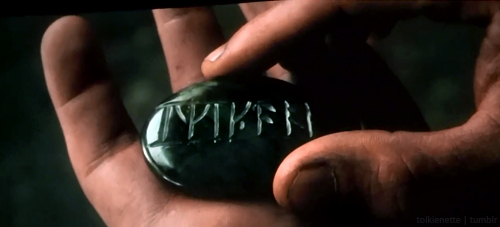When you’re obsessed Tolkien fans like we are, it doesn’t take much to send you off on a quest for knowledge that results in pages upon pages of research written entirely in runes!
It all started with one simple scene from The Hobbit: The Desolation of Smaug, when Kili the Dwarf shows Tauriel the Elf a runestone that was given to him by his mother. It is to remind him of a promise he is to keep, and though he explains it’s meaning, we just had to know more about those mysterious runes!
Philippa Boyens shed some more light on this unique stone in a recent interview with Collider,
“ […] it’s made from a stone called labradorite which is a stone that I’ve never come across before. But anyone who’s never encountered labradorite before should go and look it up, because it’s extraordinary. It’s very dark and deep.”
It was wonderful to read more about the stone but it still left our questions about the runes unanswered.
I patiently waited for an eager fan to take a stab at translating these runes. After no real luck and endless Internet searching, I pushed the issue to the back of my mind. That is until I took a closer look at the Denny’s Hobbit Menu. Look closely at the runes featured at both the bottom and top:
Coincidence? I think not! They are in fact the EXACT same runes that are featured on Kíli’s runestone. The only difference being that the rune sequence is repeated two times. The second time, there is a “command” (the little line) missing from the fourth rune.
Here is a closer look at the runes themselves:
Interestingly enough, they are NOT depicted in Cirth Erebor, the obvious choice for this company of Dwarves. Instead they are written in Cirth Moria (such as those seen on Balin’s tomb in Fellowship of The Ring). An interesting choice I must say. That being said, these runes translate to INIKHDÊ. Now that was the easy part.
What came next lead all of us here at Middle-earth News on a bit of a wild goose chase! This word, INIKHDÊ, has no direct translation in Khuzdul (the language of the Dwarves). After furiously searching through Khuzdul word roots, prefixes, and other bits and pieces, we came to a complete dead end.
However, we would not give up our quest for answers! Who better to look to than David Salo, world-renowned Middle-earth linguist. Salo has done translations and language construction for both Peter Jackson’s The Lord of the Rings and The Hobbit. After a conversation with us via email, he posted this explanation for us to his blog,
“I’ve received an inquiry about the meaning of the runes on Kíli’s talisman stone. The words inscribed on it are innikh dê.
The first is the singular imperative of the verb nanakha “return, come back”, which has a triliteral root √n-n-kh which obviously has been formed from the biliteral root √n-kh “come,” which is in turn clearly related to Adûnaic nakh-. The pattern is iCCiC, as is generally the case with other imperatives.
Dê combines a preposition d(u) “to, toward” (whose real-world inspiration is the Gothic preposition du) with the 1st person singular pronominal suffix -ê.
The meaning of the phrase on the stone is therefore “return to me.” Its precise application in Kíli’s case is something I’m not privy to, and I expect that passionate film fans can guess it more easily than I can.”
Well there you have it folks!! Kíli’s runestone can be officially translated to “RETURN TO ME” and we can all agree that makes perfect sense in the context of the movie. Kíli’s mother gave him the runestone to remind him to keep his promise to her. She simply wished for him to return to her.






Pingback: Anonymous
Pingback: Resuelta la duda sobre el talismán de Kili en El Hobbit | El Anillo Único
Pingback: Middle-earth News – Kili: A Love Less Ordinary
Pingback: Middle-earth News – An Eagle’s View of Middle-earth